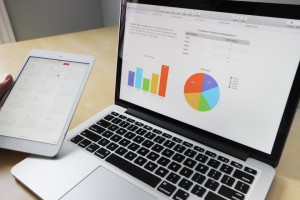 Last week, I wrote “What Is a Sales KPI? (You May Have It Wrong),” which explored the purpose of a Key Performance Indicator in a sales organization and how you may have been approaching it all wrong.
Last week, I wrote “What Is a Sales KPI? (You May Have It Wrong),” which explored the purpose of a Key Performance Indicator in a sales organization and how you may have been approaching it all wrong.
Sound familiar? Sales leaders are often faced with a predicament: “Which KPIs do I want my team focused on that will best correlate to sales success?”
In this post, we’ll dig into the difference between leading indicators and lagging indicators. And, not to worry, we’ll demonstrate how each will come into play in your newly manufactured KPI-driven sales engine.
The problem: We all know the sales manager who puts all of his attention on “what’s closing this month.” Metrics that this manager focuses on are things like total dollars closed (of course, this is most important), number of deals closed, average deal size, sales cycle or number of new customers secured. These are lagging indicators — they are the output of the work that came before it. These are very important things to be tracking, but it’s not the right place to start when it comes to managing your salespeople’s time and effort.
It’s Called a Leading Indicator for a Reason.
You can define leading indicators as strategic steps taken to trigger future outcomes. There are many ways to look at a leading indicator KPI. In layman’s terms, we want you to encourage your team by asking: “What proactive steps are my salespeople taking in the short term that will ultimately stimulate success in the long term?” If, for example, you want to increase your average deal size, some leading indicator metrics could be related to value building — number of VP-level conversations, completing prospect ROI calculations or consistently pitching an important bolt-on product.
Leading indicators are inherently proactive. Most importantly, sales teams need to focus on leading indicators to effectively steer performance in a positive direction, allowing them to work on what they can do to improve their results.
Can I get an amen? We have experienced this with even our own customers. Those that are the highest-achieving companies are focused on achievement on the leading side of the sales process.
As another way to look at it, let’s take preparation in baseball. Baseball players study the pitcher closely over the course of a ballgame to educate themselves on the pitcher’s habits and tendencies before they’re at-bat. Sure, they can focus on their own batting average instead, but that lagging indicator is unlikely to help when they step into the batter’s box.
Similarly, in making an online purchase, I will often read several reviews and research buyer trends before purchasing a laptop computer or cell phone that might indicate whether it will sync well with the technology. Get the idea? In life, we lead by putting our best foot forward and focusing on the here and now.
Avoid Lag Drag; Embrace Sales KPI Buzz
Lagging indicators can be a drag. When you constantly nag your sales team about hitting sales quotas, it can be destructive and poisonous to the entire environment. Recent research has shown that employees are more productive in a work environment in which they are enjoying themselves, according to a study by the Society for Human Resource Management. Nagging won’t get you there.
Injecting leading indicators into your sales approach provides the involvement that is often lacking on sales teams. Leading indicator KPIs offer direction and are geared to help individuals achieve their goals. The approach also offers the opportunity for more engaged coaching and improved communication. It’s a win-win-win.
So it’s clear: Leading indicators are the secret formula that will contribute to sales productivity. And even better yet, working together as a sales team to learn which indicator will be most suitable as a core sales KPI will get you buy-in and increase your team’s ownership over their own performance. This will ultimately produce improved accountability on all levels.
Now that you get the difference between a leading and a lagging Indicator, we’ve got some tips to allow you to act on these newly learned KPI insights. Ready? Stay tuned. We’re polishing up our next post as we speak.




